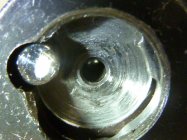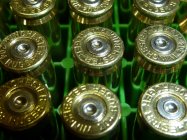First of all, I have considerable experience with a firing pin with a .062 tip diameter. I have shot a Stiller Viper action that has one, for many years, and really like this feature, but, if your firing pin hole edges are nice and square you may solve a cratering problem without bushing the bolt face. A friend has a couple of Panda actioned short range benchrest rifles that he shoots with loads that are very stout. Not wanting to have his bolt face damaged by primer failure, and seeing a small amount of cratering, given that his firing pin fit is good, he shimmed his firing pin spring and the problem went away, even with the very stout load. He has a lathe so this sort of thing is easy for him to do. Years ago someone mentioned, in an article in Precision Shooting, that the proper shape for a Remington 700 pin tip has two radii, a larger one in the center and smaller at the edges. A change to this shape is not difficult if needed. With a hemispherical tip, under peak pressure, the pin is pushed back a bit so that the full diameter of the tip goes below the bolt face a bit, leaving a wedge shape space around the edge, providing room for the primer cup to be cratered. With a flatter shape this is less of an issue. Not many know that there are a couple of sources for firing pins that come with oversized tips that are designed to be fitted to a close fit to the hole. I believe that one is Pacific Took and Gauge, and the other is Holland Shooters Supply. Many hears back I had one from Holland, from a review that I had written, and I gave it to a friend who had a cratering problem with one of his 700 varmint rifles. He fitted it, and it solved his problem. Getting back to my Viper, it has been my experience that I can get away with a lighter firing pin spring with its tip diameter, with no accuracy issues. If you have an issue wiht a larger tip diameter the first two things that I would suggest you do is to check the weight of your spring, and take a look at the tip shape.














